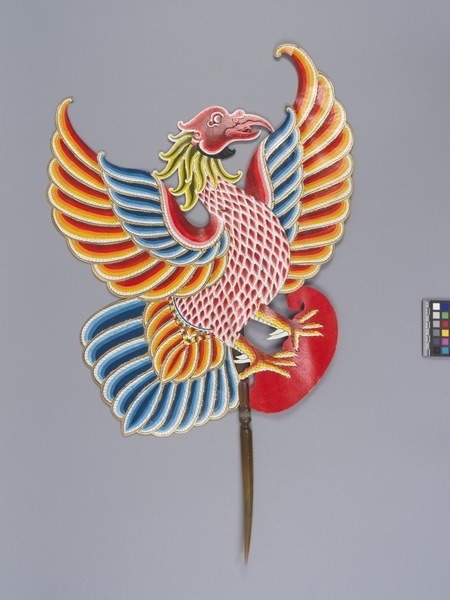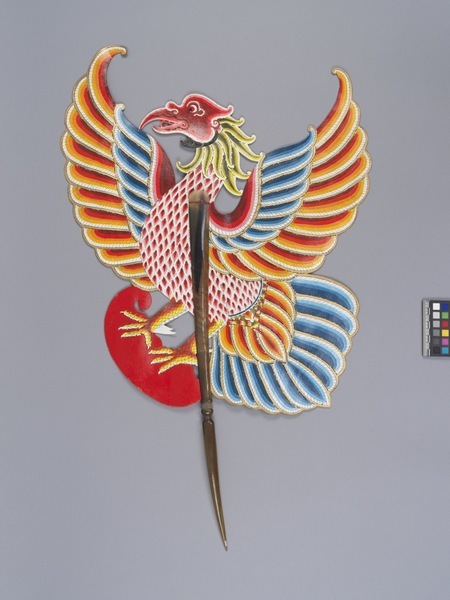Shadow Puppet Item Number: 3340/6 from the MOA: University of British Columbia


Description
Jatayu character wayang kulit (shadow puppet) from Ramayana series. Flat shadow puppet cut from hide. Large bird with wings spread. His feathers are various shades of reds, blues, oranges with white highlights. His red chest feathers are in a diamond-like pattern, and yellow flame-like feathers extend down from his red head. Operated by one central horn rod.
History Of Use
Wayang kulit shadow play is over a thousand years old. It is thought to be derived from the leather shadow puppetry of southern India, like tholu bommalata, which came to Java with the spread of Hinduism in the first millennium. In Java--part of the largely Islamic Republic of Indonesia--this highly distinctive form of shadow puppetry is valued as a pusaka, a sacred treasure of the royal court of Yogyakarta. The plays are performed to mark special occasions, such as birthdays, marriages, and religious events. They have also been adapted for television and for public education campaigns. At the heart of all performances is the dhalang, the leading artist, puppeteer and gamelan orchestra leader. With immense energy, drama, humour and creativity, the dhalang is responsible for manipulating the puppets; for interpreting their personalities and gestures; for speaking in their particular voices; for narrating the story and for conducting the gamelan orchestra— gongs, xylophones, drums, bowls, vocals, strings. When the play is about to begin, the dhalang places one of his gunungan or kayon—a large leaf-shaped shadow puppet-form representing a tree of life or sacred mountain—in the centre of the screen to separate the opposing groups of puppets and to announce that the cosmic order is in balance. Part way through the play, chaos descends when the four clown characters--Semar and his sons, Bagong, Gareng and Petruk--make an entry. They enliven and delight the audience with their crude and comic behaviours, jokes and songs.
Item History
- Made by Pak Sagio (Maker) in Yogyakarta, Java, Indonesia during 2008
- Owned by Sutrisno Hartana before January 28, 2019
- Received from Sutrisno Hartana (Seller) and Museum of Anthropology Exhibitions Budget (Funding source) on January 28, 2019
What
- Name
- Shadow Puppet
- Identification Number
- 3340/6
- Type of Item
- puppet
- Material
- water buffalo skin, water buffalo horn, paint and cotton fibre
- Overall
- height 77.0 cm, width 46.5 cm, depth 2.5 cm
Who
- Culture
- Javanese
- Creator
- Pak Sagio (Maker)
- Previous Owner
- Sutrisno Hartana
- Received from
- Sutrisno Hartana (Seller) and Museum of Anthropology Exhibitions Budget (Funding source)
Where
- Holding Institution
- MOA: University of British Columbia
- Made in
- Yogyakarta, Java, Indonesia
When
- Creation Date
- during 2008
- Ownership Date
- before January 28, 2019
- Acquisition Date
- on January 28, 2019
Other
- Condition
- good
- Accession Number
- 3340/0006